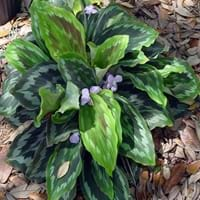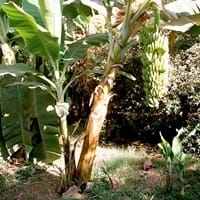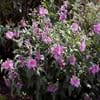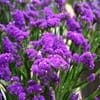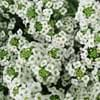Type
Tender Perennial
Tender Perennial
Origin
Southeastern Asia
Hybrid origin
Types
Not Available
Flowering Plants, Fruits, Herbs
Number of Varieties
Not Available
Habitat
Shady Edge
Subtropical climates, Tropical rainforest, Tropical regions
USDA Hardiness Zone
8-12
8-15
AHS Heat Zone
12-10
Not Available
Sunset Zone
H1, H2, 21, 22, 23, 24
H1, H2, 14, 15, 16, 17, 18, 19, 20, 21, 22, 23, 24
Habit
Clump-Forming
Clump-Forming
Flower Color
Purple, Lavender
White, Yellow, Purple, Brown
Flower Color Modifier
Bicolor
Bicolor
Fruit Color
Not Available
Green, Light Green
Leaf Color in Spring
Green, Light Green
Green
Leaf Color in Summer
Green, Dark Green
Green
Leaf Color in Fall
Green, Dark Green
Green
Leaf Color in Winter
Light Green
Light Green
Leaf Shape
Arrowhead
Oblanceolate , Ovate
Plant Season
Spring, Summer, Fall
Spring, Summer, Fall, Winter
Sunlight
Partial shade
Full Sun, Partial Sun
Type of Soil
Loam, Sand
Loam, Sand
The pH of Soil
Acidic, Neutral
Acidic, Neutral, Alkaline
Soil Drainage
Well drained
Average
Bloom Time
Early Summer, Summer, Late Summer, Early Fall
Indeterminate
Tolerances
Drought
Drought
Where to Plant?
Ground
Container, Ground
How to Plant?
Divison, Tubers
Divison
Plant Maintenance
Medium
Medium
Watering Requirements
Requires regular watering
Water every two or three days during warmer months
In Summer
Lots of watering
Lots of watering
In Spring
Moderate
Moderate
In Winter
Average Water
Average Water
Soil pH
Acidic, Neutral
Acidic, Neutral, Alkaline
Soil Type
Loam, Sand
Loam, Sand
Soil Drainage Capacity
Well drained
Average
Sun Exposure
Partial shade
Full Sun, Partial Sun
Pruning
Remove damaged leaves, Remove dead branches, Remove dead leaves
Remove damaged leaves, Remove dead branches, Remove dead leaves
Fertilizers
All-Purpose Liquid Fertilizer
All-Purpose Liquid Fertilizer
Pests and Diseases
Red blotch
Red blotch
Plant Tolerance
Drought
Drought
Flower Petal Number
Single
Not Available
Foliage Texture
Medium
Bold
Foliage Sheen
Matte
Glossy
Attracts
Not Available
Insects
Allergy
Not Available
Anaphylaxis
Aesthetic Uses
Ground Cover
Not Available
Beauty Benefits
Not Available
Not Available
Environmental Uses
Air purification
Air purification
Medicinal Uses
Carminative, Diuretic, Exoectorant, Pectoral, Stimulates new cell growth, Throat infection
anti-cancer, Asthma, Diarrhea, Improve heart health, increase memory, lowering blood pressure, Potassium
Part of Plant Used
Flowers, Leaves
Flowers, Fruits, Leaves, Root, Sap
Other Uses
Oil is used in perfume, soaps, creams, etc.
Animal Feed, Fine spines and trichomes are used as fiber for weaving, Leaves used for wrapping food, Pulp can be used to make rope place mats and other goods
Used As Indoor Plant
Yes
No
Used As Outdoor Plant
Yes
Yes
Garden Design
Container, Groundcover, Tropical
Edible, Fruit / Fruit Tree, Mixed Border, Screening / Wind Break, Tropical
Botanical Name
KAEMPFERIA elegans
Musa acuminata × Musa balbisiana
Common Name
Peacock Ginger
Banana, Hybrid Banana, Saba Banana
In Hindi
Peacock Ginger
Saba kela
In German
Pfau Ingwer
saba Banane
In French
paon gingembre
saba banane
In Spanish
jengibre pavo real
saba plátano
In Greek
παγώνι τζίντζερ
saba banana
In Portuguese
gengibre pavão
saba de banana
In Polish
paw imbiru
saba banana
In Latin
gingiberi pavo
Saba Musa sapientum fixa
Phylum
Magnoliophyta
Magnoliophyta
Class
Liliopsida
Liliopsida
Order
Zingiberales
Zingiberales
Family
Zingiberaceae
Musaceae
Clade
Angiosperms, Commelinids, Monocots
Not Available
Tribe
Not Available
Not Available
Subfamily
Not Available
Not Available
Importance of Peacock Ginger and Saba Banana
Want to have the most appropriate plant for your garden? You might want to know the importance of Peacock Ginger and Saba Banana. Basically, these two plants vary in many aspects. Compare Peacock Ginger and Saba Banana as they differ in many characteristics such as their life, care, benefits, facts, etc. Every gardener must at least have the slightest clue about the plants he wants to plant in his garden. Compare their benefits, which differ in many ways like facts and uses. The medicinal use of Peacock Ginger is Carminative, Diuretic, Exoectorant, Pectoral, Stimulates new cell growth and Throat infection whereas of Saba Banana is anti-cancer, Asthma, Diarrhea, Improve heart health, increase memory, lowering blood pressure and Potassium. Peacock Ginger has beauty benefits as follows: Not Available while Saba Banana has beauty benefits as follows: Not Available.
Compare Facts of Peacock Ginger vs Saba Banana
How to choose the best garden plant for your garden depending upon its facts? Here garden plant comparison will help you to solve this query. Compare the facts of Peacock Ginger vs Saba Banana and know which one to choose. As garden plants have benefits and other uses, allergy is also a major drawback of plants for some people. Allergic reactions of Peacock Ginger are Not Available whereas of Saba Banana have Anaphylaxis respectively. Having a fruit bearing plant in your garden can be a plus point of your garden. Peacock Ginger has no showy fruits and Saba Banana has showy fruits. Also Peacock Ginger is not flowering and Saba Banana is not flowering . You can compare Peacock Ginger and Saba Banana facts and facts of other plants too.
